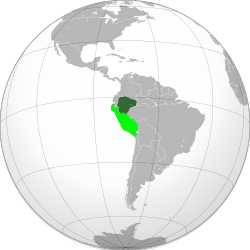Federal State of Loreto Estado Federal de Loreto(Spanish) | |||||||||
|---|---|---|---|---|---|---|---|---|---|
| 1921–1922 | |||||||||
 Loreto within Peru in 1921 | |||||||||
| Status | Unrecognised self-proclaimed federated state within Peru | ||||||||
| Capital | Iquitos | ||||||||
| Official languages | Spanish | ||||||||
| Demonym | Loretan | ||||||||
| Government | De jure autonomous federated state | ||||||||
| Leader | |||||||||
• 1921–1922 | Guillermo Cervantes | ||||||||
| Historical era | Leguía presidency | ||||||||
• Insurrection declared | 5 August 1921 | ||||||||
• Peruvian forces occupy Iquitos | 13 January 1922 | ||||||||
| Currency | Cervantine banknotes [a] | ||||||||
| |||||||||
The Federal State of Loreto [b] was an unrecognised self-proclaimed federated state within Peru that was proclaimed during an insurrection in 1921 headed by Peruvian captain, Guillermo Cervantes. It was formed from the Department of Loreto and existed as de facto autonomous region of the country. It was dissolved in 1922, after the rebellion was crushed by Peruvian forces. The state was one of many attempts proclaimed in order to gain more autonomy for the region as well as reform Peru into a federal state. Its capital was Iquitos.